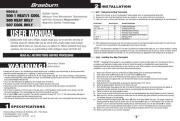Braeburn 2000NC Manual
| Mærke: | Braeburn |
| Kategori: | Termostat |
| Model: | 2000NC |
Har du brug for hjælp?
Hvis du har brug for hjælp til Braeburn 2000NC stil et spørgsmål nedenfor, og andre brugere vil svare dig
Termostat Braeburn Manualer

2 Januar 2025

11 November 2024

11 November 2024

11 November 2024

11 November 2024
Termostat Manualer
Nyeste Termostat Manualer

2 December 2025

1 December 2025

28 November 2025

27 November 2025

27 November 2025

27 November 2025

27 November 2025

27 November 2025

27 November 2025

26 November 2025
